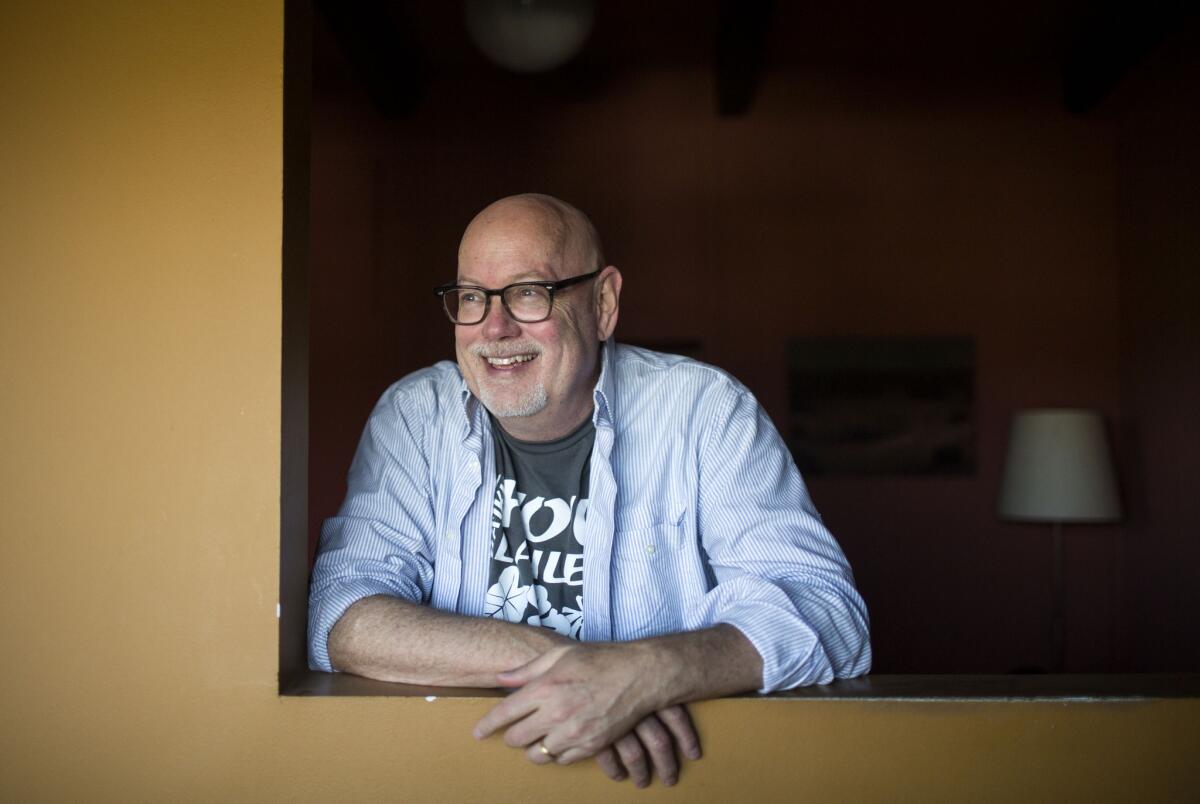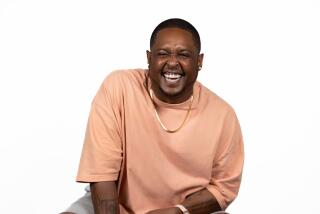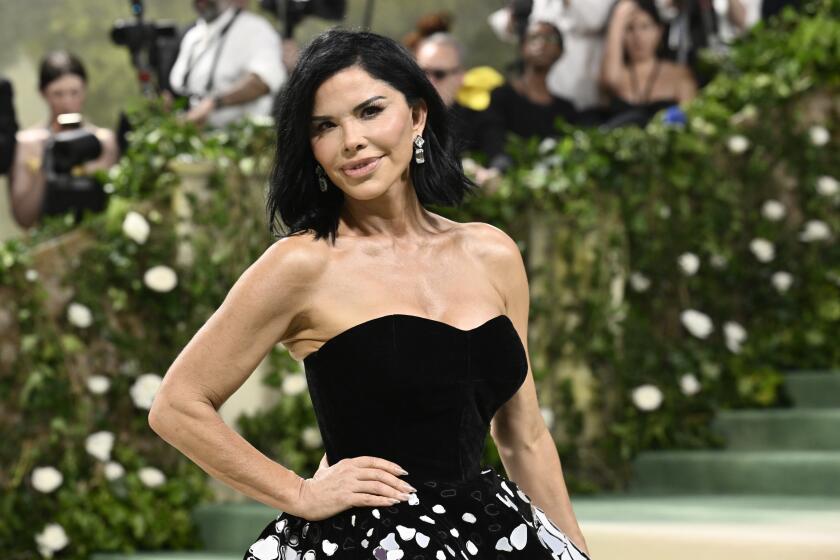Mark Haskell Smith bares all to live nudist life for ‘Naked at Lunch’

Mark Haskell Smith has written “Naked at Lunch,” a book about his immersion in the world of nudist culture. He was photographed at his home in Eagle Rock.
Mark Haskell Smith wears clothes to meet a reporter at a Los Feliz café.
Smith, the author of “Naked at Lunch: A Reluctant Nudist’s Adventures in the Clothing-Optional World” (Grove: 320 pp., $25), doesn’t seem particularly amused by this observation. He says he’s fielded his share of lame witticisms since he began his firsthand investigations into nudism. Throughout his time in a nude community in France, on a nude Alpine walking tour and on a nude cruise, he remained — as his subtitle proclaims — a reluctant nudist.
“Part of the fun of the book is seeing how awkward I am in my own skin when there’s nothing to hide behind,” he says.
Bearded and fair-skinned, Smith orders a latte and positions himself under an umbrella so that no sunlight falls on his bald head. He is so prone to sunburn that he consulted his dermatologist before embarking on his adventures and applied many layers of sunscreen along the way.
Raised in Kansas, he came to L.A. and broke into screenwriting in the 1990s. He published five novels before writing a nonfiction book about renegade marijuana growers, “Heart of Dankness,” published in 2012.
“I went around the world smoking the best cannabis,” he says. “I really had fun writing nonfiction. I got to travel, meet people. So then I was thinking, ‘What other subculture is quasi-legal, oppressed by the police? Nudism.’” Despite his personal discomfort with “nonsexual social nudism” (as proponents of this lifestyle describe it), Smith knew he had to immerse himself in the scene, just as he had with cannabis. He complains that someone writing a book about wine in Italy would be expected to go to Italy and drink wine, yet with ‘Heart of Dankness,” critics responded, “Well, Smith was stoned all the time.” “Yeah, because I was writing about being stoned all the time.”
At moments during his nudist journey, Smith admits his courage faltered: A week before he was to share a house with 19 naked European strangers in the Alps, he got an email from the organizer saying that a Spanish documentarian was coming along to capture them on film. “Yay, how great is that?” he says wanly. “Can’t wait to be on film!”
But when Smith arrived, his housemates were so friendly that his anxiety faded. He enjoyed hiking without clothing, in spite of a cut sustained while scrambling over rocks. “And there’s a lot of liberation in just not [caring] what people think... There’s all this body image stuff we’re bombarded with, like, ‘Oh, I have a gut. I’m the only one here circumcised.’ Which, if you’re a man, on a mountain with snow, is not the greatest thing. Like, ‘Why can’t I have that extra layer?’”
Smith discovered multiple benefits to going through the day without clothing: “The vitamin D intake is very good. It’s easy to check for ticks. When you get out after swimming, there’s no clingy suit.” Even so, Smith admits that he never quite became a card-carrying nudist. He remains a “textile” — nudists’ derogatory term for clothing wearers.
Nudism, after all, has its drawbacks: “Criminal prosecution, sunburn, bug bites, getting your picture taken and put on the Internet.” He adds resignedly, “You can find that Spanish documentarian’s footage on YouTube.”
Smith’s longtime editor at Grove/Atlantic, Jamison Stoltz, says he was drawn to the project because Smith “came in as an outsider but a very sympathetic outsider. He can capture the characters and the quirkiness of this world without it being condescending or ‘Look at the freaks!’”
Although Smith’s approach is humorous — his writing becomes especially vivid when he describes genitals, and he includes an entire chapter on the evolution of pubic hairstyles — he pokes more fun at himself than at his subjects, many of whom take their lifestyle seriously. Historically, he found, nudists write a lot of manifestoes.
“Because they’re oppressed. So they have to take a political stance to protect the thing that gives them pleasure,” he explains. But nudism “doesn’t really hurt anybody,” he continues. “You see a naked person, it’s not going to give you PTSD. If you find a naked body offensive, look away.”
If Smith were the president of the United States, would clothing be optional? “I do think if we were more tolerant of people who wanted to be naked, that would make us a better society.”
Smith attributes Americans’ squeamishness both to our Puritan forebears and to marketing. “The fashion-cosmetic-industrial complex pushes a body image,” he says, almost as though rehearsing a manifesto of his own. “It tells us, ‘You’re unhappy because you’re ugly and deformed. If you put on these clothes and this makeup and go to this gym and eat this diet stuff, you’ll be happy, because you’ll look how happy people look.’
“Nudism is the opposite. I’m happy with my body, I don’t need your clothes: That is a completely anti-capitalist statement. If everybody did that, our economy would crash.”
For all its politics and its humorously awkward moments, “Naked at Lunch” contains a surreptitious love story: Smith persuades his wife of 12 years, Diana Faust, to accompany him on his final adventure, the nude Caribbean cruise. A more reluctant nudist even than he, Faust initially turned him down.
“The exact quote was ‘No …. way,’” Faust recalled over the telephone. “I don’t think I’ve laughed nearly so hard as when he told me they actually bought that book and were going to make him go naked around the world. He’s a funny, funny guy, but that was the funniest thing I’d ever heard.”
But upon learning that the double-occupancy cabin was paid for and would go to waste, Faust reconsidered. Also, she says, “We had this line in our wedding vows: ‘I promise to show you a good time.’ Sometimes showing people a good time means being way out of your comfort zone, if that’s helpful to them.”
Gray is a writer in Los Angeles.
More to Read
Sign up for our Book Club newsletter
Get the latest news, events and more from the Los Angeles Times Book Club, and help us get L.A. reading and talking.
You may occasionally receive promotional content from the Los Angeles Times.







